viola whitacre’s bread and butter pickles, c. 1952
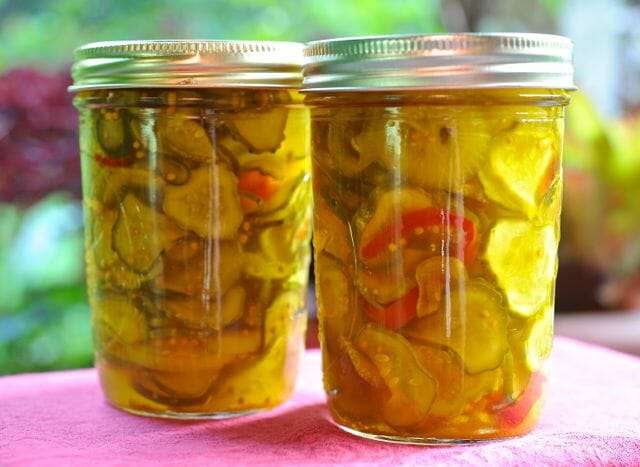 I HAD A DOUBLY SWEET WEEK: the chance to speak at the meeting of a great group of gardeners in Kent, Connecticut—and to leave the event with not just new friends, but also two pints of bread and butter pickles from Viola Whitacre’s 1952 recipe, as handed down to the gardener who arranged the event, Nancy Schaefer. In a continuing chain of hand-me-down tradition, I’ll share them here with you.
I HAD A DOUBLY SWEET WEEK: the chance to speak at the meeting of a great group of gardeners in Kent, Connecticut—and to leave the event with not just new friends, but also two pints of bread and butter pickles from Viola Whitacre’s 1952 recipe, as handed down to the gardener who arranged the event, Nancy Schaefer. In a continuing chain of hand-me-down tradition, I’ll share them here with you.
“Of all the kinds of pickle I make,” says Nancy, “they are my favorite. They are very sweet, I admit, but I think that’s why they are eaten with simply bread and butter, to balance out the sweetness.” (I had them that way for lunch Saturday. My first pickle sandwich ever was perfect, with a slice of goat cheddar and a few cherry tomatoes on the side.)
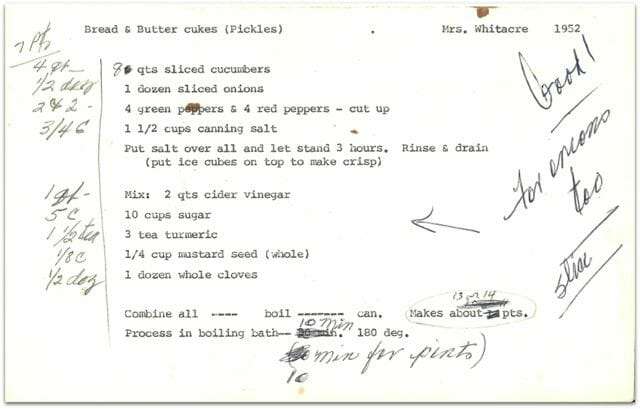
“Mom got it from our over-the-back-fence neighbor in Michigan,” Nancy recalls. “Viola Whitacre and her husband, Archie, lived in the house behind ours. Archie was the gardener; Viola kept the house and was the kind of neighbor who made us special cookies and shared jars of these wonderful bread and butter cukes, as she called them. I find making these pickles a very satisfying experience—and the finished product is so good!”
viola whitacre’s 1952 bread and butter pickles
adapted by Nancy Schaefer
THESE EXCEPTIONAL PICKLES–extra thin and very sweet–are in more of a light syrup than a brine. They can be cold-packed as refrigerator pickles, or hot-packed in a boiling-water bath, doubling their shelf life from about six months to a year or so. The recipe presumes familiarity with basic canning. Details on tinkering with the sugar is included just below the recipe, as are Nancy’s suggestions on using the syrup creatively after the pickles are devoured.
Ingredients
- 8 quarts small kirbies (about 32-36 pickling cucumbers—choose small ones no more than 5 inches long and 1½ inches diameter so the seeds will be very small)
- 1 dozen small white bulb onions (2 inches diameter or smaller)
- 4 large red bell peppers
- 1 cup canning salt (don’t be frightened of this amount—you wash it off before you make the pickles)
- ice cubes
- 1 quart white vinegar and 1 quart cider vinegar
- 10 cups of granulated sugar
- 3 teaspoons turmeric
- ¼ cup mustard seed
- 1 dozen whole cloves
Steps
Wash the cukes and slice them very thin—no more than 1/8 inch—you will be repaid for this tedious task! (Note from Margaret: A mandoline would help, but Nancy is a true master with her knife, I can attest.)
Wash and peel the onions and slice them into rings about ¼-inch thick.
Wash and seed the peppers and slice them into ¼-inch strips.
Place the sliced cukes, onions and peppers in a large bowl, putting in a layer, salting it well, then placing six or so ice cubes on top before adding the next layer of vegetables, salt and ice. Cover and let stand for three hours.
If you are going to can your pickles, get everything ready to do that while you wait.
Whether you plan to hot or cold pack, with a half hour to go, make the pickling liquid now, too:
Mix 1 quart white vinegar and 1 quart cider vinegar in a large non-reactive pot (no aluminum or untreated cast iron; stainless or enamelware are ideal, though turmeric will stain pale-colored enamel finishes).
Add 10 cups of granulated sugar, 3 teaspoons turmeric, ¼-cup mustard seed, and 1 dozen whole cloves. Stir this together well and bring it to a boil, covered.
Rinse and drain the bowl of sliced vegetables, and repeat by refilling the bowl with fresh tepid water and drain again, three times. Drain very well, then add the mix to your pot of (furiously) boiling pickling liquid. Make sure the sliced vegetables are immersed, then cover the pot and bring it back to a gentle boil.
If you are going to can them, you want to have everything ready to start doing that now. Fill the jars and process them in a boiling water bath for 10 minutes.
Alternatively, for refrigerator pickles, simmer the pot of cukes for an extra 5 minutes, then ladle them (with the liquid) into clean jars. Once cooled, keep them in the fridge. They will keep quite well for six months or so. Canned jars are good for a year or more on the shelf—if they last that long!
The recipe can be successfully halved, but doubling it is not recommended, as it is too much to process at one time. Makes 13 or 14 pints.
I have put the recipe in a pdf that you can download and then print at home.
pickles: how sweet it is (or isn’t)
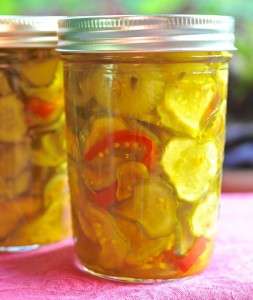
“I don’t know if you ever make three- or four-bean salads,” she says, “but some of the pickle, chopped, with a little pickling liquid and some onion is very good with beans. Sometimes I add just a little pickle liquid to my potato salad for variety, too.” I put chopped pickles in my egg salad, with a tiny bit of mayo—so I think that’s where little splashes of mine is headed, once the pickles are consumed.
If you want to tinker with the sweetness, first read what one of my favorite tinkerers, Deb Perelman of Smitten Kitchen, says about doing so; her bread and butter pickle recipe calls for ¾ cup of sugar for one quart yield of pickles (which would be about half what Viola’s style uses).
The similarly amazing Heidi Swanson of 101 Cookbooks pickles zucchini in a brine that includes sugar, and also acknowledges that the sugar can be adjusted. Again: Note that these recipes, Heidi’s and Deb’s, are for much smaller quantities of pickles, but when you do the math the sugar adds up—though not to Viola’s decadent degree. I highly recommend indulging in the 1952 version at least once (with the warning you may do it every summer thereafter, as the very-sweet-herself Nancy Schaefer has for a lifetime).
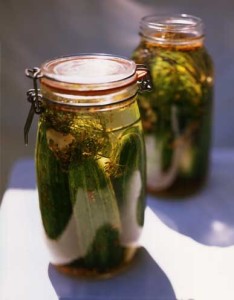


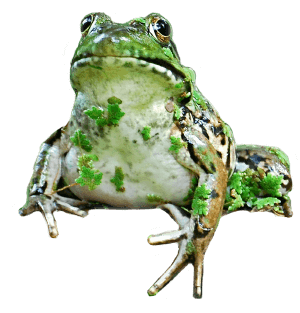


I have never used a boiling water bath with bread and butter pickles. I don’t think it is needed. Just make sure jars, lids and stuff are hot and sterile. I’ve been making b&b pickles for 40 some years this way and have never had a problem. My 15 yr. old
grandaughter eats them for breakfast (sugar)!
Hi, Anne. Yes, the old-style rules don’t always call for all the hot-packing, and I have done both ways, but the USDA guidelines on food safety have really changed…and apparently Viola Whitacre hot-packed hers even in 1952! Canning is an art, right? Everyone does it a little differently. Nice to see you!
anyone have a recipe for water melon rind pickles? the flavor of the syrup sounds the same but not sure how to process the rinds…
I don’t have one myself, Doreen…good idea — makes me want to go hunting!
I do the Watermelon pickle rinds……..Look on my Pinterest page under canning for the recipe…..Roni Crincoli on Pinterest…..We love them……..
These were super easy and the results were superb. Just like I remember from my childhood. My Vermont family had some more obscure pickle traditions, too, and watermelon rind pickles were among them. We never had mac and cheese w.o them. Also, my uncle used to make what he called “tongue pickles” from small yellow (ripe or over ripe) cukes. Although the name is a bit off-putting, they were really good. If anyone knows a recipe for either, I hope they post….
This reminds me that I should look up my mom’s bread and butter pickle recipe from the 1940’s, I just love those old typed cards, so many of ours are all stained, with added notes from various years. You’ve inspired me to post about some of these recipes for putting up veggies this weekend. Isn’t sad how today we have so little time to can? Well, after reading your book, not you perhaps, at least now, but there was a time…..right? When time was something SO valuable that it was wasted commuting, writing performance reviews, attending critical meetings and balancing budgets. I think I choose Bread and Butter Pickles over those times!
Loved your lecture and am busy reevaluating the garden for color and texture.
Just want to repeat that The peach clofoutis recipe was a huge success (made four and gave three away) and my freezer is loaded with frozen peaches (as per your instruction) and three peach pies. Bumper crop this year to make up for the zero production of pears and apples.
Thanks for all the good advice about the pickles- The cukes are growing as we speak. I give them away but they grow right back again in the am. So the recipe is my next resort/
Thanks for sharing!!
reminds me of my Grandmother, thanks for the sweet memory of her
Thank you for all these great pickle recipes. My husband & I loved the pickles my father in law use to make. He was aNYC firemen and use to cook a lot in the kitchen at the fire station in the Bronx. Unfortunately when he passed away we no longer have home made pickles. We can’t wait to try these bread & butter pickles & Dans kosher dills as well!
Have an un related gardening question.
After 40 +years the Magnolia tree we bought our mom for mothers day succumbed to disease so we replaced it ( for mothers day of course) it’s been planted for two years now. This year it bloomed in spring. But two weeks ago it started producing several flowers..what’s unusual is they form these big beautiful buds but never open. We live on Long Island. Any idea why this is happening? Thank you!
Here is a link to the recipe that I used to make watermelon rind pickles. They are yummy and look like big yellow jewels in the jar. https://www.pickyourown.org/watermelonrind_pickled.htm
I also used this recipe to make watermelon jelly from the watermelon core. It is very good too. https://pickyourown.org/watermelonjelly.htm
Happy canning!
So nice of you to share it, Mimi. The PickYouOwn site is so helpful, good suggestion!
This is really good recipe and thanks for sharing it. I only wish the finished pickle was crisper – I understand the issue of food safety – so I’m afraid to NOT use the hot water bath. I’ve tried using a pressure cooker , but the results are the same. My pickles are way to soft and mushy – but they taste delicious. Does anyone else have the same issue ?
Hi, Stella. Let me ask Nancy, who gave me the recipe and has been making it for many years!
Stella,
An update from Nancy, who shared the recipe:
Spent the weekend freezing cucumbers-So easy in sweetened vinegar.
They’ll e crunchy in winter salads.
I am wondering if you could use any kind of pepper in these pickles….if you wanted to use jalapeno do you think you could replace all of the bell peppers? If anyone has tried this I would love to know what you did and how they turned out.
Hi, Christi. Since it’s a sweet pickle (sort of bread and butter style) I don’t know about Jalapenos in the mix — I think you could replace a small amount to add some kick, but I think the sweet/sour thing here is the main flavor target.
If you are looking for that satisfying sweet/hot thing, we will slit a cayenne or a Thai chili and tuck it into the occasional jar of sweet pickles just before we process them. Delicious!!
After attending the pickle festival in NYC one year, I learned to make all varieties of B&B pickles. My fave is either adding small sliced jalapeños to the step when you gently simmer the cucumber slices or you make pickled jalapeños (cowboy candy) and then add that to the hot jar before sealing. Those are my sweet and spicy pickles.
Also, I use a recipe that uses honey instead of white sugar and they still come out sweet without being too sweet and unbelievably don’t taste like honey.
This is now my B and B recipe and I have shared your website with my canning friend. I tried other recipes w less sugar but the were not as good. Love these pickles before dinner on the patio with the sharpest cheddar cheese I can find. It has become my summer staple and everyone always loves it
Thanks!
What is meant by the “white small bulb onion”?
Hi, Cynthia. Small white onions — but not scallions; actual regular onions that are bulbs, but white not yellow, and small ones (like the ones used in creamed onions).
Make these pickles! Serve them at the end of summer with ritz crackers and sharp cheddar cheese. Has to be ritz. And, whatever your drink of choice is after a day of mowing and watering and mowing. You will deserve it and you will feel appreciated!